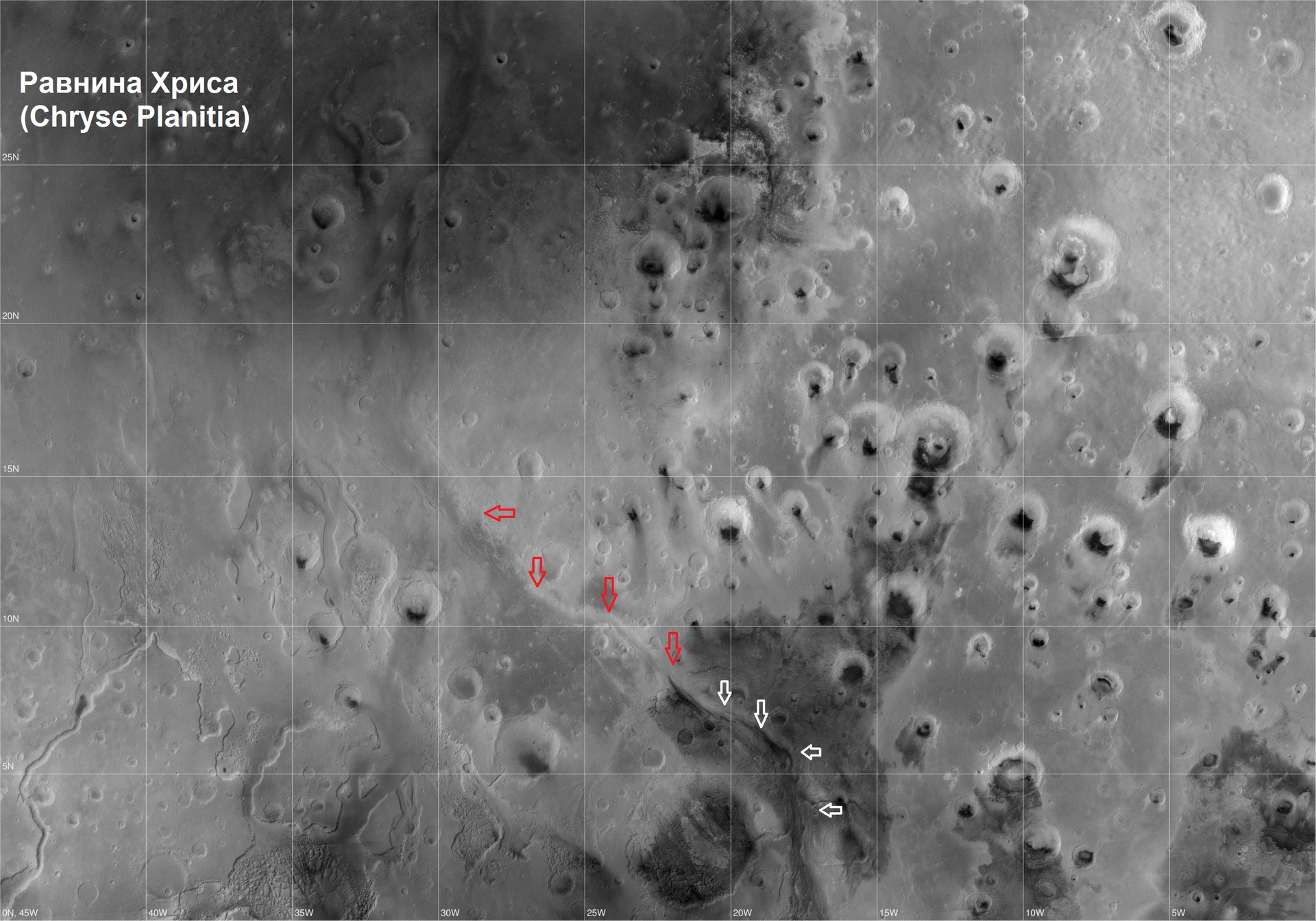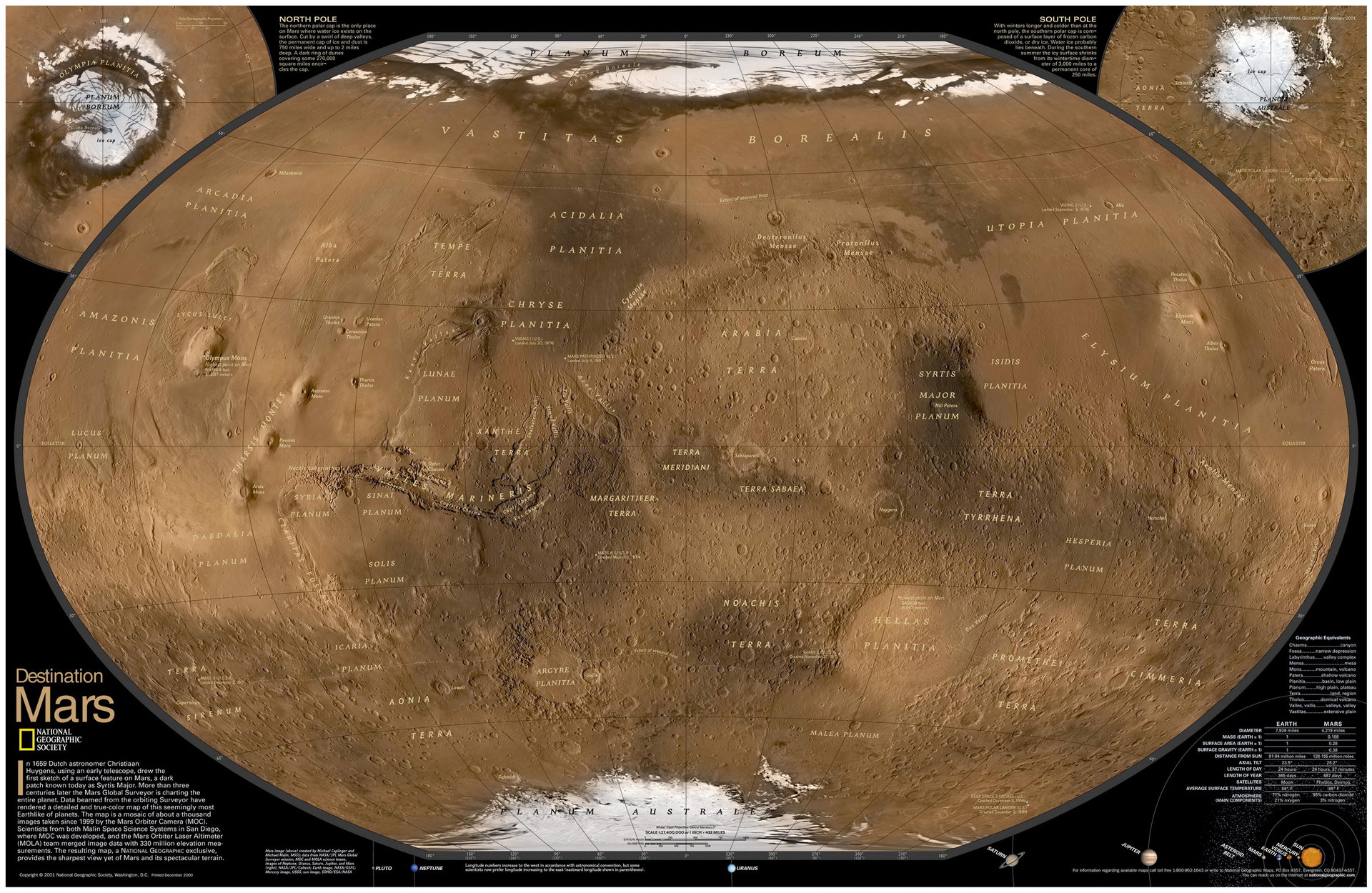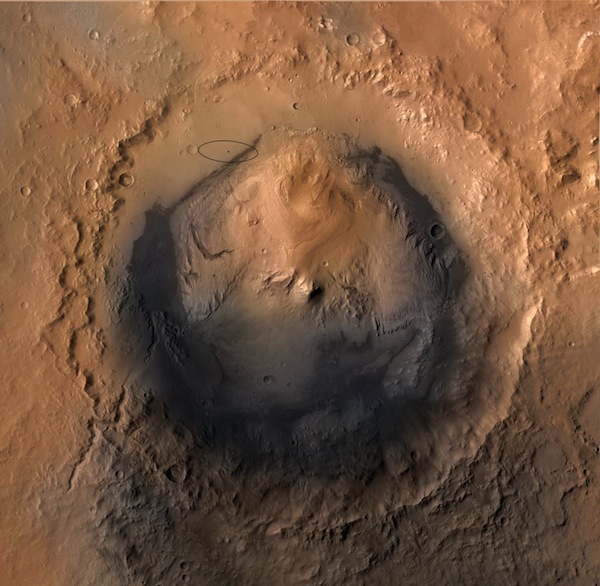Mars yesterday and today. Brief chronicle of geological robots

Since the flight of the Soviet station Mars 1 in 1963, four dozen artificial messengers of the Earth visited the vicinity of the red planet, more than 10 vehicles reached the surface of the planet. In sum, a huge amount of information was obtained that changed forever our ideas about the red planet. From the possible cradle of higher life forms, Mars appeared as a dry and cold world.
However, this world was not always like this. Mars’s geological past is divided into three periods:
Noah's era
It begins with the formation of the surface of Mars more than 4 billion years ago. Huge impact craters on the surface of Mars are hundreds and thousands of kilometers characteristic of the regions that formed at that time. These zones occupy the main part of the southern hemisphere of the planet, where the first vehicles made landing, which reached the surface of Mars - Mars 2, 3 and 6. These same regions were the first to be removed during the first successful flight of the Mariner 4 in 1964.

')
In that era, Mars had a very dense atmosphere and an impressive hydrosphere — the global oceans. Moreover, the Opportunity rover, which has been working on Mars for 10 years now, and Erebus and Endeavor primarising close to the ancient craters, discovered convincing evidence of the existence of fresh water billions of years ago. At the same time, Mars had a high-grade magnetic field, the remnants of which were first recorded by Soviet stations Mars 2, 3 and 5 (it is 500 times weaker than the earth), as well as plate tectonics, as on Earth (Mars Global Surveyor).
The hypothetical oceans of Mars by the end of the Noika era:

The end of the Noisky era was marked by the end of the Heavy Bombardment 3.5–3.7 billion years ago, during which most of the above-mentioned craterized regions were formed. The surface of our moon also took its modern look in that era. At the same time, the 154 km Gale crater was formed, which in the following epochs, like the Gusev crater, will be filled with water.
Hesperian era
The geology of Mars is no longer determined by meteoric impacts, but by the onset of volcanic activity. This era was intermediate, during which large volcanoes of the province of Farsis - Olympus, Mount Arsiya, Pavlina and Askriyskaya, and also the highlands of Elysium began to form. According to the most popular hypothesis among scientists, this activity could be an echo of the collision of Mars with a large planetoid with a diameter of 2000 km at the dawn of its existence. This would explain the appearance of a giant Northern Basin on Mars.

Already in the Hesperian era, Mars had a constant hydrosphere - the ocean that occupied the northern plains was comparable in size to the current Arctic Ocean on Earth. In this subpolar region, the Odyssey orbiter discovered huge deposits of ice beneath the surface, which was confirmed by the successful operation of the Phoenix device fitted here. Another ocean occupied the Utopia lowland (Utopia planitia), in the northern hemisphere, chosen for the Viking 2 workplace. In low and temperate latitudes there were many rivers and lakes (Gale crater, Gusev crater). The formation of Farsid Province (Tarsis) probably led to of a giant canyon known as the mariner valley. The canyon was discovered by the first artificial satellite of Mars - Mariner 9 in 1971.
Volcanoes of the Farsida region (Tarsis), on the left the largest in the solar system volcano Olympus. On the right is the largest canyon in the solar system of the Mariner Valley.

Mars Hesperian era:

Huge glaciers on the high plateaus to the south of this region, melting, flowed through the valleys of the Mariner to the northern plain of Chris, causing huge floods. On this plain, which scientists had long since interested (thanks to the work of Mariner 9), in the 70s the apparatus Viking 1 worked.
Amazonian era
By the beginning of the next, Amazonian era 2.5 billion years ago, Mars had a dense atmosphere similar to Earth, with high temperatures (up to +30) and pressures up to 1 bar (about 100,000 Pa). At the same time, the valley of Ares (south of the plateau of Chris) formed, through which a stream larger than the Amazon flowed into the Northern Ocean from the southern highlands. Mars Pathfinder was operating in this valley in the 97th year.
Valley of Ares (indicated by arrows), "flowing" on the plain of Chris:

The Amazonian era is characterized by a long process of catastrophic climate change on Mars. The largest volcanic regions of Elysium and Farsid were formed, the seas and oceans appeared and disappeared. About 1 billion years ago, Mars took a modern look. Most likely, the reason is the gradual cooling of the depths of Mars, the dispersion of its atmosphere due to low gravity and huge temperature differences on geological time scales caused by the instability of the axis of the planet’s daily rotation (the stability of the Earth axis is supported by the Moon).
Modern Mars:

The most interesting is the possibility of life on the planet in wet and warm times, it is possible that it could exist at the junction of the Hesperian and Amazonian eras (and perhaps today). Clarifying the geological past of Mars could shed light on this question. From this point of view, the sedimentary rocks covering the mountain Aeolis (formerly Sharp mountain) in the center of the Gale crater are of exceptional interest. Presumably they have accumulated over 2 billion years and can tell a lot about the past of the planet and the processes that took place in a lake that in ancient times filled the crater.
Gale's crater and Curiosity landing site / Original video of the landing of the rover in Gale's crater:

Initially, the Spirit rover was to descend into Gale's crater, but due to the lack of sophistication of technology at that time, the choice was changed to the Gusev crater. Today, Mount Eolida is the main goal of the Curiosity rover.
According to the Mars Global Surveyor, Mars Odyssey, Mars Reconnaissance Orbiter orbiters and largely due to the work of the European Mars Express, the water reserves of the northern and southern polar caps of Mars are estimated at 2.4 million km3 (four times more than the Black Sea). And taking into account the recorded reserves under the surface of Mars - 52 million km3 of water, which is almost three times the volume of the Arctic Ocean.
Mars Mars polar cap, spectrometer Mars Express. Light pink is marked by “dry” ice (CO2), from green to blue mainly water ice:

Mars Express Orbital Motion Video:
Atmospheric pressure on Mars is about 700 pa, highly dependent on altitude. Under such conditions, the existence of liquid water on the surface is impossible. With the exception of the bottom of the Mariner valleys and the Hellas Planitia region in the southern hemisphere of the planet. Since they are 7 km below the average Martian level, the atmospheric pressure is twice as high as usual - up to 1,400 Pa, which allows for the existence of liquid water on the surface at temperatures from 0 to 10 ° C (normal summer temperatures in these latitudes). The extremely low pressure that a person is able to endure is 30 times higher — 35,000 Pa.
However, conditions on Mars do not reject the possibility of the existence of a primitive life adapted to extreme conditions (like extremophiles on Earth). Moreover, climatic changes on the Red Planet took place rather slowly, so that living organisms could adapt to them. In any case, tests for the presence of living organics, conducted by the Viking series in the 70s, did not allow for unequivocal conclusions about this.
Source: https://habr.com/ru/post/221833/
All Articles